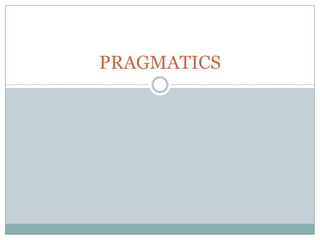
Pragmatics Explained: How Context Shapes Meaning
- 1. PRAGMATICS
- 2. Pragmatics is a systematic way of explaining language use in context. It seeks to explain aspects of meaning which cannot be found in the plain sense of words or structures, as explained by semantics. The study of what speaker‟s mean.
- 3. Invisible Meaning Pragmatics is the study of „invisible‟ meaning, or how we recognize what is meant even when it isn‟t actually said or written.
- 4. DEIXIS Deixis is reference by means of an expression whose interpretation is relative to the (usually) extra linguistic context of the utterance, such as who is speaking the time or place of speaking the gestures of the speaker, or the current location in the discourse.
- 5. Kinds of deixis We use deixis to point to things (it, this, these boxes) and people (him, them, those idiots), sometimes called person deixis. Words and phrases used to point to a location (here, there, near that) are examples of spatial deixis, and those used to point to a time (now, then, last week) are examples of temporal deixis.
- 6. PRESUPPOSITION What a speaker (or writer) assumes is true or known by a listener (or reader). for example> A: What about inviting John tonight? B: What a good idea; then he can give Monica a lift Your brother is waiting outside. Why did you arrive late?
- 7. SPEECH ACT The action performed by a speaker with an utterance. I’ll be there at six, you are not just speaking, you seem to be performing the speech act of „promising‟.
- 8. Direct and Indirect Speech act Structures Meanings Did you eat the pizza? Interrogative Question Eat the pizza (please)! Imperative Command (Request) You ate the pizza. Declarative Statement Direct Speech Act Can you ride a bicycle? Indirect Speech Act can you pass the salt?
- 9. POLITENESS Showing awareness of and consideration for another person‟s face. Face is your public self-image. This is the emotional and social sense of self that every one has and expects every one else to recognize.
- 10. If you say something that represents a threat to another person‟s self-image, that is called a face- threatening act. for example : Give that pepper! could you pass me that pepper?
- 11. Negative and Positive Face Negative Face is the need to be independent and free from imposition. I‟m sorry to bother you...; I know you‟re busy, but.... Positive Face is The need to be connected, to belong, to be a member of the group. Let‟s do this together...; You and I have the same problem, so....
- 12. CONVERSATIONAL IMPLICATURE a message that is not found in the plain sense of the sentence. The speaker implies it. The hearer is able to infer (work out, read between the lines) this message in the utterance, by appealing to the rules governing successful conversational interaction.
- 13. Conversational Maxims Quality: speakers should be truthful. They should not say what they think is false, or make statements for which they have no evidence. Quantity: a contribution should be as informative as is required for the conversation to proceed. It should be neither too little, nor too much. (It is not clear how one can decide what quantity of information satisfies the maxim in a given case.) Relevance: speakers' contributions should relate clearly to the purpose of the exchange. Manner: speakers' contributions should be perspicuous: clear, orderly and brief, avoiding obscurity and ambiguity.
- 14. Maxims violations Carson is driving John to Meredith‟s house. CARSON: Where does Meredith live? JOHN: Nevada. Maxim Violated: Quantity. Why: There is clash between quantity and quality. Carson is looking for a street address, but John gives a weaker, less informative statement (hence the quantity violation). If John really doesn‟t know anything more specific, however, he cannot give a more informative statement without violating quality.
- 15. SIMON: When are you coming home? ELIZABETH: I will codify that question to my superiors and respond at such a time as an adequate answer is preparable. Maxim Violated: Manner; Elizabeth is using unnecessarily complicated and confusing words and construction. Implication: Elizabeth does not know or does not wish to give an answer to the question.
- 16. MEREDITH: You really love me? JOHN: I like Ferris wheels, and college football, and things that go real fast. Maxim Violated: Relation; John is changing the topic. Implication: Either John doesn‟t want to respond to Meredith (perhaps he has problems discussing his feelings) or the answer is “no.”
